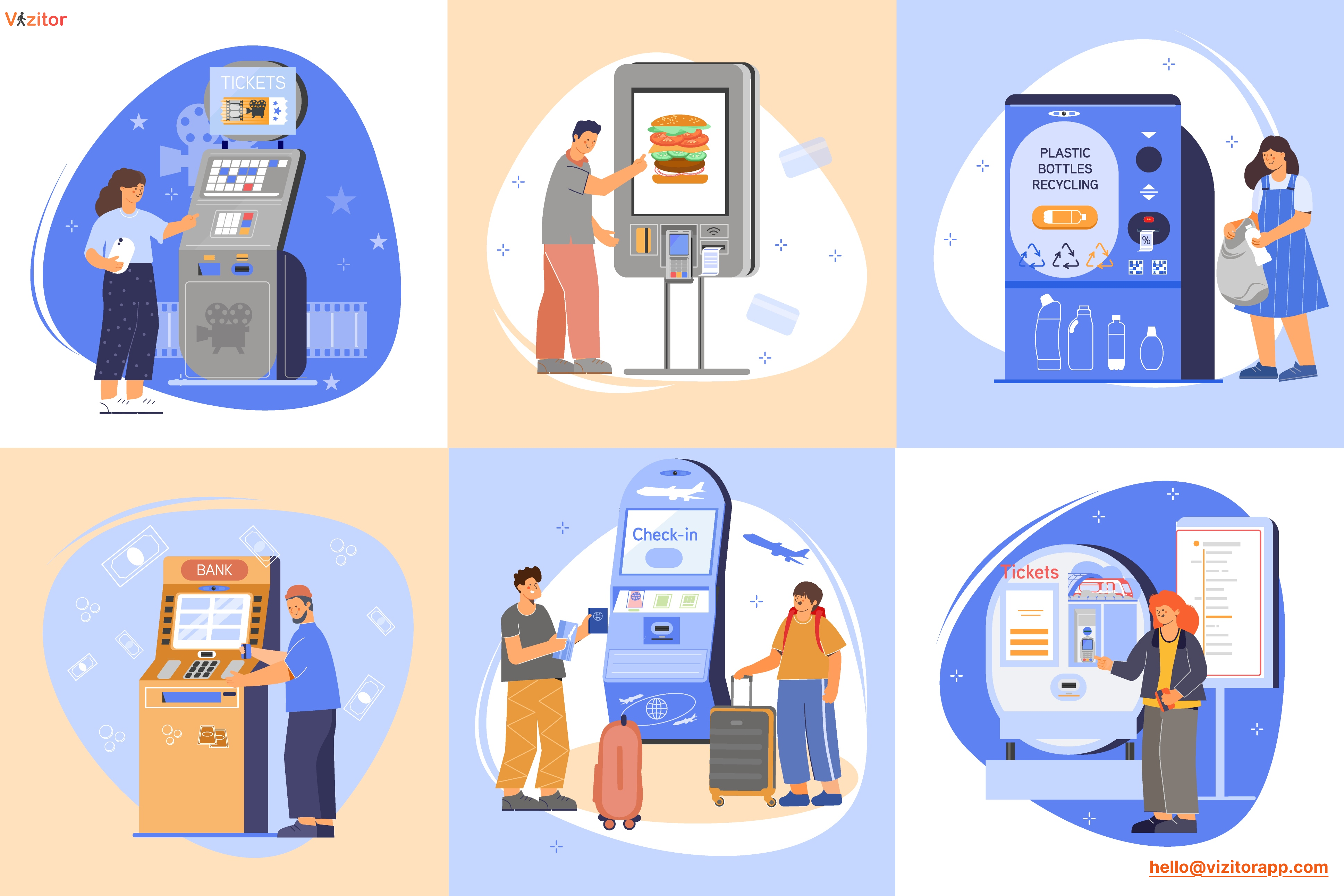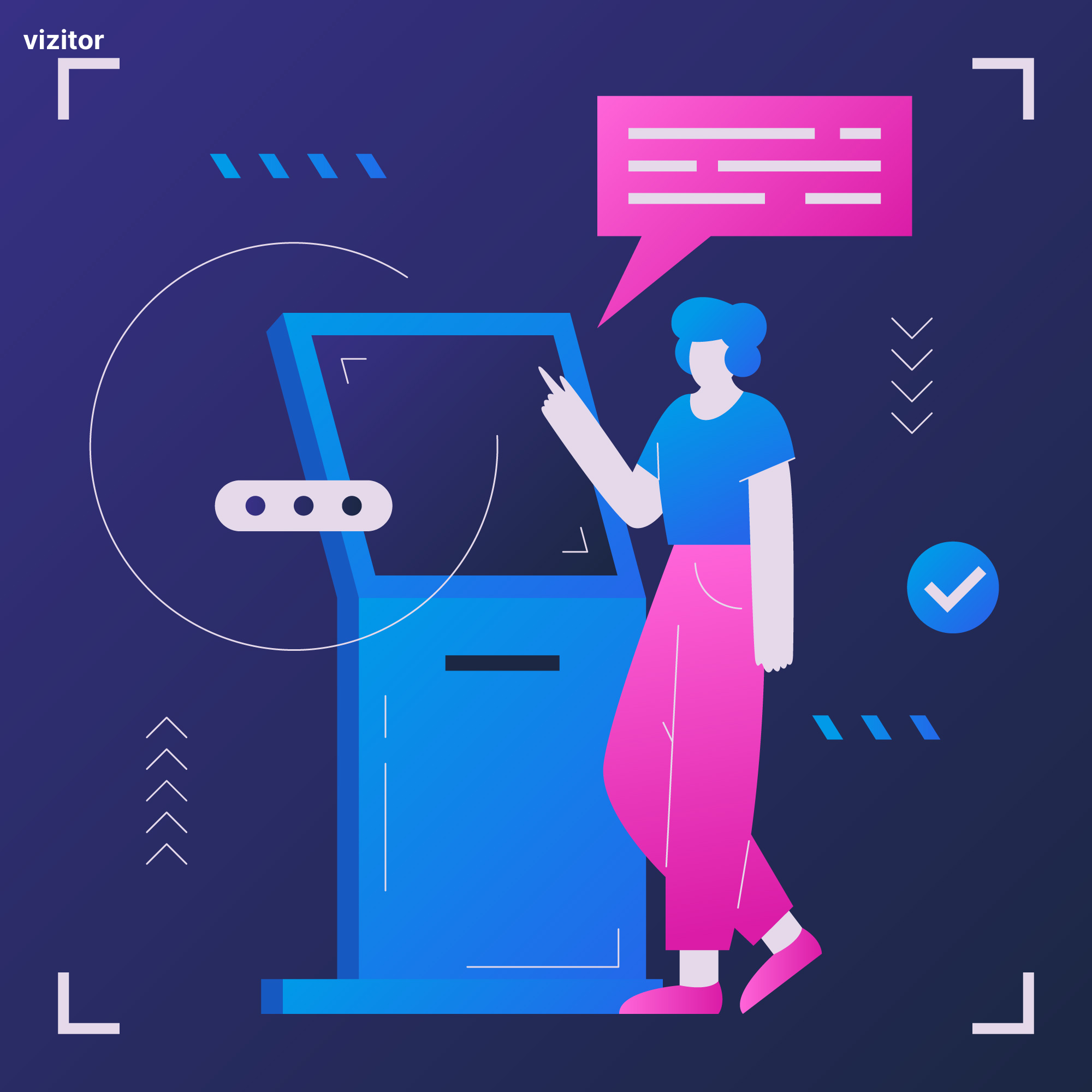Table of Content
Try Vizitor for Free!

Tue, Dec 24, 2024
Read in 15 minutes
Suppose you walk into a crowded bank on a Friday afternoon. Dozens of people are already waiting, and the thought of standing in line for an hour feels frustrating.
But,
Now imagine you spot an electronic kiosk standing tall in the middle of the room, inviting you to complete your check-in or register with just a tap of your finger. In seconds, you’re on your way, with minimal wait time and zero hassle.
This is the magic of digital kiosks: transforming chaotic customer experiences into seamless, efficient interactions.
With the advent of digital kiosks, companies are redefining the way queues are managed, delivering faster services and happier customers.
Efficient queue management is critical for businesses in today’s competitive world.
Long waiting times not only frustrate customers but also impact brand reputation. In such a scenario, electronic kiosks have emerged as a revolutionary solution to streamline the queuing process.
From reducing waiting times to enhancing customer experience, kiosks offer a bundle of benefits.
In this post, we’ll learn how electronic kiosks are transforming the queuing experience at different Workplaces reducing waiting times, and improving customer satisfaction.
What do you mean by Electronic kiosks?
Electronic kiosks, also known as digital kiosks, are self-service machines designed to assist users in performing specific tasks. From ticket booking to food ordering, kiosks are becoming an essential aspect of digital signage and customer interaction.
Electronic kiosks are transforming the way businesses manage queues.
By enhancing efficiency, improving customer satisfaction, and reducing operational costs, kiosks are a win-win solution for businesses and customers alike.
According to a report by MarketsandMarkets, the global self-service kiosk market is projected to grow from $28.8 billion in 2023 to $45.8 billion by 2028, showcasing their rising importance across industries.
Whether it’s a retail store, a hospital, or a government office, managing queues efficiently is critical to ensuring a smooth customer experience.
Equipped with advanced technology, digital kiosks automate mundane tasks like check-ins, ticketing, and payments, significantly reducing wait times.
Did You Know?
A study by Omnico Group found that 77% of customers are less likely to return to a business after experiencing long wait times. However, businesses that implemented self-service kiosks saw a 30% increase in customer retention.
The Impact of Poor Queue Management
Queues are a part of everyday life, but their mismanagement can lead to lost customers, reduced productivity, and tarnished brand reputation.
-
Customer Dissatisfaction: Long wait times frustrate customers, leading to negative reviews and a drop in loyalty.
-
Business Losses: Research shows that 67% of customers abandon a purchase due to long queues.
-
Staff Burnout: Managing large crowds manually overwhelms employees, reducing their efficiency.
This is where electronic kiosks step in as game-changers.
What are the Different Types of Electronic Kiosks for Enhancing Queuing Processes?
Different industries have unique needs when it comes to queue management.
Electronic kiosks come in various forms, each serving specific functions that optimize queue management.
Let’s explore the types of kiosks that are making waves in multiple industries:
1. Self-Service Kiosks
Self-service kiosks enable users to complete tasks independently without the need for staff assistance. These kiosks are particularly effective in reducing queues and improving operational efficiency.

Key Features
-
Allows users to perform actions like check-ins, ticket booking, and information retrieval.Users can check-in or checkout of their own without need to physically touch or stand in long lines.
-
Equipped with intuitive touchscreens, self-service kiosks guide users through processes with ease, reducing the need for staff intervention.
-
Self-service kiosks collect valuable customer data, such as service preferences and transaction history, helping businesses make informed decisions.
-
Self-service kiosks operate around the clock, ensuring uninterrupted service for customers even during non-business hours.
-
Provides user-friendly interfaces with multiple language options.
Did you know?
✓McDonald’s self-service kiosks have reduced customer wait times by 40% while increasing sales by 30% through upselling suggestions on the screen.
✓Over 85% of airports worldwide, including Heathrow and JFK, use self-service kiosks for check-ins, saving passengers an average of 10 minutes per check-in.
2. Touchscreen Kiosks
In traditional manual queue management systems, customers are often required to rely on staff for tasks like registration, ticketing, or gathering information.
While this process has been in use for decades, it has significant drawbacks in today’s fast-paced world:
-
Long Wait Times: Manual systems are time-consuming, especially during peak hours, as staff can only assist one person at a time.
-
Human Errors: Errors in data entry, ticket distribution, or service allocation can lead to mismanagement and customer dissatisfaction.
-
Poor Customer Experience: Customers often feel frustrated due to long waits and inconsistent service quality.
Touchscreen electronic kiosks have become an effective solution for modern customer service, offering an interactive, user-friendly interface that makes tasks like registrations, bookings, and payments more efficient.
These kiosks rely on touch technology, making it easy for users to navigate menus, enter data, and complete transactions.
Key Features
-
Touchscreen kiosks feature high-resolution, responsive screens that provide an engaging user experience.
-
Customers can quickly complete tasks without relying on staff, reducing queue times significantly.
-
Using ATM Kiosks,customers can withdraw money, check account details, or deposit cash without visiting a teller.
-
Touchscreen kiosks in malls allow customers to search for products, check availability, and locate stores.
-
Restaurants use touchscreen kiosks for self-ordering and payments, minimizing errors and speeding up service.
-
At hospitals,patients can use touchscreen kiosks to register, book appointments, and make payments, reducing the need for manual paperwork.
These electronic touchscreen Kiosks are capable of handling multiple processes, such as product browsing, information lookup, or queue ticket generation, all on a single interface.
3. Payment Kiosks
Payment kiosks are self-service terminals designed to facilitate secure, quick, and convenient payment processes without the need for human assistance.
From retail stores to parking lots, these kiosks have become a vital tool for businesses looking to improve operational efficiency and customer experience.
Key Features
-
Easy-to-navigate touchscreen interfaces for a seamless payment experience.
-
Payment kiosks reduce transaction times by up to 40%, ensuring faster checkouts.
-
Payment kiosks support a wide range of payment modes, enhancing customer convenience
-
Multilingual options to cater to a diverse customer base.
-
Customers can make payments for their purchases directly at the kiosks, reducing the burden on checkout counters at retail stores.
Stats:
-
68% of consumers prefer self-service kiosks for faster transactions.
-
Retailers using payment kiosks report a 30% reduction in checkout times.
-
Parking facilities with automated payment kiosks have seen a 20% increase in revenue due to efficient fee collection.
4. ATM Kiosks
With their ease of use, availability, and cost-efficiency, ATM kiosks have become a crucial part of modern banking services, providing customers with 24/7 access to their accounts and financial services.
Key Features
-
ATM kiosks are available around the clock, allowing customers to access banking services at their convenience, regardless of bank hours.
-
This eliminates the need for customers to visit the bank during regular hours, providing increased flexibility.
-
ATM kiosks support a variety of banking services, including:
- Cash Withdrawals
- Balance Inquiries
- Fund Transfers
- Bill Payments
- Account Updates
- Mini-Statements
-
Most ATM kiosks require secure PIN codes or biometric authentication, adding an extra layer of security to prevent unauthorized access.
-
Many ATM kiosks are designed to handle both cash withdrawals and deposits, offering a complete self-service banking solution.
ATM kiosks eliminate the need for additional bank staff to handle routine tasks, lowering operational costs.Banks can easily use ATM kiosks in various locations, increasing service coverage without significant infrastructure investments.
5. Digital Signage
Digital signage kiosks are interactive, electronic displays used to communicate information, advertisements, or instructions to customers in public spaces.
These kiosks combine digital screens with queue management features, offering a powerful way to engage customers and manage service delivery.
Key Features
-
Digital signage kiosks can display real-time information such as queue updates, service availability, announcements, promotions, and advertisements.
-
Many digital signage kiosks are equipped with touchscreens, allowing customers to interact with the kiosk for self-service actions such as checking the queue status, navigating through menus, or accessing additional services.
-
Digital signage kiosks provide live updates on the current queue status, expected wait times, and service availability, helping customers manage their expectations and plan accordingly.
-
Digital signage kiosks automate key tasks like ticket issuance, queue management, and information sharing, reducing the need for staff involvement.
6. Ticketing Kiosks
Ticketing kiosks are crucial for businesses that handle large crowds or events. These kiosks allow customers to quickly purchase or collect their tickets without waiting in long lines, reducing congestion and improving overall event experience.
Key features
-
Instant Ticket Issuance: Customers can instantly print their tickets or access digital tickets, saving time and eliminating the need for manual interventions.
-
Self-Service Convenience: Ticketing kiosks enable self-service for customers, reducing the reliance on staff and allowing businesses to streamline their operations.
By enabling customers to self-serve at digital ticket kiosks, industries can reduce the strain on staff, eliminate long queues, help manage queues by assigning tokens and enhance the overall customer experience.
Also read: The Ultimate Guide to Ticketing kiosks
How Digital Kiosks Enhance the Queue Management Process?
Integrating digital kiosks into a queue management system offers a smoother, more efficient experience for both businesses and customers.
Our Queue Management System, Vizitor, offers a seamless and streamlined customer experience by automating customer check-ins, reducing wait times, and providing real-time updates.
Below, we’ll explore how Vizitor offers integration with electronic kiosks to enhance the queue management process:
1. Customer Arrival and Check-In
Step: Self-Registration through Digital Kiosks
-
Customer Interaction: When customers arrive at a location (e.g., banks, hospitals, airports), they are greeted by an electronic digital kiosk.
-
Self-Service Check-In: Customers interact with the touchscreen interface to enter required details (e.g., name, service type, appointment time).
-
Instant Ticket Generation: The Digital kiosk generates a ticket with a unique queue number and the designated service counter details. This ensures faster processing and eliminates the need for manual check-ins.
With Vizitor’s Queue Management System, the self-service process is streamlined. The system efficiently collects visitor information, prints a ticket with queue details, and automatically syncs the ticket with the next available counter, minimizing wait times.
2. Queue Ticket Issuance and Number Assignment
Step: Automatic Ticketing
-
Ticket Generation: Once the customer is registered, the kiosk prints a queue ticket, automatically assigning them a unique number and service counter.
-
Queue Position: The ticket displays the customer’s position in the queue along with the estimated wait time and counter number.
-
Real-Time Updates: As the queue progresses, the system updates and displays the next available counter on digital screens or kiosks.
3. Queue Information Display and Monitoring
Step: Real-Time Queue Updates on Digital Signage
-
Digital Signage Integration: Digital signage kiosks display real-time updates on queue status, including current waiting times and the status of service counters.
-
Queue Updates: Customers can monitor their queue status, check available counters, and track real-time wait times. This reduces anxiety by keeping customers well-informed.
4. Automated Real-Time Notifications
Step: Automated Progress Updates
-
Queue Movement: As the customer’s number nears, they are notified either via SMS, email, or on-screen alerts at the kiosk.
-
SMS/Push Alerts: These notifications inform customers when it’s time to proceed to the service counter, eliminating unnecessary waiting.
Vizitor’s digital kiosks enhance this process by automatically sending out SMS or email alerts to customers when their number is about to be called.
This helps keep customers informed and ensures they are ready when it’s their turn.
5. Service Delivery at Counter
Step: Seamless Transition from Queue to Service
-
Queue Number Displayed at Counter: As the customer’s queue number is called, it appears on a monitor at the service counter.
-
Customer Approaches the Service Point: Once notified, the customer proceeds directly to the assigned counter, ensuring a smooth transition from waiting to service.
6. Real-Time Analytics and Reporting
Step: Data-Driven Insights
-
Queue Analytics:Vizitor collects detailed data on wait times, queue performance, and service delivery speed. This data is used to generate actionable insights.
-
Business Insights: The system allows businesses to analyze queue efficiency, optimize staffing levels, and identify peak times, ultimately improving operational efficiency.
What are various key benefits of using Electronic kiosks for your business?

Increased Efficiency:
Electronic kiosks automate processes like check-in, ordering, and payment, reducing waiting times and enhancing service speed.
Cost Savings:
By reducing the need for staff to handle routine tasks, kiosks help lower labor costs and improve operational efficiency.
Improved Customer Experience:
Self-service kiosks offer convenience, allowing customers to quickly access services on their own terms, enhancing satisfaction.
24/7 Availability:
Kiosks operate round the clock, providing customers with constant access to services, even during non-business hours.
Reduced Errors:
Digital Automation minimizes human error, ensuring tasks like transactions and orders are completed accurately every time.
Better Queue Management:
Kiosks help manage queues efficiently by assigning customers to available service counters, reducing congestion and wait times.
Read more: How Online Queue Apps make business Workflow easier
Scalability:
These electronic Kiosks can be easily added to existing infrastructure as your business grows, supporting increased customer demand without needing more staff.
Security and Privacy:
Digital Kiosks offer secure payment processing and ensure customer data is handled with privacy, building trust and reducing fraud risks.
| Features | Benefits |
|---|---|
| Self-Service Capability | Reduces staff workload and empowers customers to take control of their tasks. |
| Queue Optimization | Minimizes waiting times by managing queues efficiently |
| Customer Satisfaction | Improves customer interactions by providing faster, transparent services. |
| Cost efficient | Lowers operational costs by automating manual tasks. |
| Data insights | Collects customer data to identify peak hours and optimize operations. |
How Digital Kiosks Are Transforming Different Industries?
From enhancing customer experience to streamlining operations, digital kiosks have proven to be invaluable in modernizing how industries operate.
Digital kiosks are becoming an essential tool for businesses and organizations across various sectors.
1. Retail Industry
At busy retail stores,customers often abandoned purchases due to long checkout lines.
Retailers use digital kiosks for in-store self-service, enhancing customer convenience. Customers can browse products, check prices, place orders, and even pay without waiting in long lines.
Walmart, one of the largest retailers, has installed self-checkout kiosks in many of its stores, reducing long queues and improving the shopping experience for customers.
According to a report, Walmart’s self-checkout system helped them increase their transaction efficiency by 20%.
2. Healthcare Industry
In healthcare facilities, patients often struggled with manual registration processes.
But,digital kiosks help streamline patient check-ins, reducing administrative workload and wait times.
Patients can verify their details, update medical records, and even make payments, all without waiting for assistance.
Studies have proven that Healthcare institutions that adopted kiosks saw a continuous reduction in patient wait times.
3. Hotels and Restaurants
Hotels and restaurants often face challenges in managing customers especially during peak hours. They usually face problems as:
-
Delays during check-in and check-out.
-
Inconsistent guest service during peak hours.
-
High staffing requirements for manual check-in processes.
Digital kiosks in hotels enable guests to check in, choose their rooms, and even make payments, reducing the need for a traditional front desk. This is especially valuable during peak seasons when hotel staff may be overburdened.
According to reports, hotels that introduced kiosks experienced a 35% decrease in guest complaints about check-in.
4. Transportation and Travel
Airports, train stations, and bus terminals utilize digital kiosks for ticketing and boarding, making the travel process more efficient and less time-consuming for passengers.
5. Banking and Financial Services
Banks have adopted digital kiosks for tasks such as account management, cash deposit, balance checks, and even loan applications.
This reduces the need for in-branch visits and allows customers to access services outside regular banking hours.
By adopting digital kiosks, businesses can not only optimize their operations but also create a more satisfying and efficient experience for their customers, positioning themselves as leaders in their respective industries.
How Vizitor Simplifies Queue Management with Electronic Kiosks
Vizitor’s Queue Management System provides features for creating seamless queue management solutions that integrate with electronic kiosks. Our platform is designed to:
- Automate check-ins and token issuance.
- Display queue progress using digital signage.
- Provide real-time analytics to optimize customer flow.
Why Choose Vizitor?
- Customizable Solutions: Tailored to suit your industry’s unique needs.
- Seamless Integration: Works flawlessly with your existing systems.
- Enhanced Customer Experience: Delivers faster service and transparent queue updates.
- Data insights:Collect visitor data and feedback for continuous service improvement.
By combining speed, efficiency, and engagement, Vizitor QMS provides a modern alternative to outdated manual systems, ensuring businesses stay competitive in today’s technical world.
How to Choose the Right Electronic Kiosks for Your Business?
1. Determine Business Needs:
Depending on the type of business (retail, healthcare, hospitality, etc.), the requirements for kiosks may differ. It’s essential to select kiosks that best meet specific operational goals.
2. Hardware and Software Compatibility:
Ensure that the kiosk hardware (screen size, payment options, security features) and software (user interface, payment gateways, analytics) align with your business needs.
3. Cost vs. Benefit:
Evaluate the upfront costs, maintenance, and expected ROI of implementing digital kiosks to make an informed investment decision.
4. Location Planning:
Place kiosks in high-traffic areas where customers can easily access them without obstructing walkways or causing congestion.
The Environmental Benefits of Implementing Electronic Kiosks for modern workspaces
-
Reduced Paper Usage: By replacing traditional paper-based systems with digital kiosks, businesses can significantly reduce paper waste and contribute to environmental sustainability.
-
Energy Efficiency: Many modern digital kiosks are designed to be energy-efficient, using LED screens and low-power technology, reducing their environmental footprint.
So, as industries evolve and customer expectations continue to rise, digital kiosks will only grow in their importance. The future is digital, and integrating kiosks into your operations is no longer a luxury—it’s a necessity for growth and customer satisfaction.
Ready to Upgrade Your Queue Management?
Whether you’re looking to reduce wait times or streamline processes, electronic kiosks can help you achieve all of this and more.
Discover how Vizitor’s Queue Management System can help you implement these digital kiosks in your business to optimize operations.
Don’t wait! Connect with us today to explore how we can help you transform your business with the power of digital kiosks.
Unlock the Power of Digital Kiosks with Vizitor Now!









